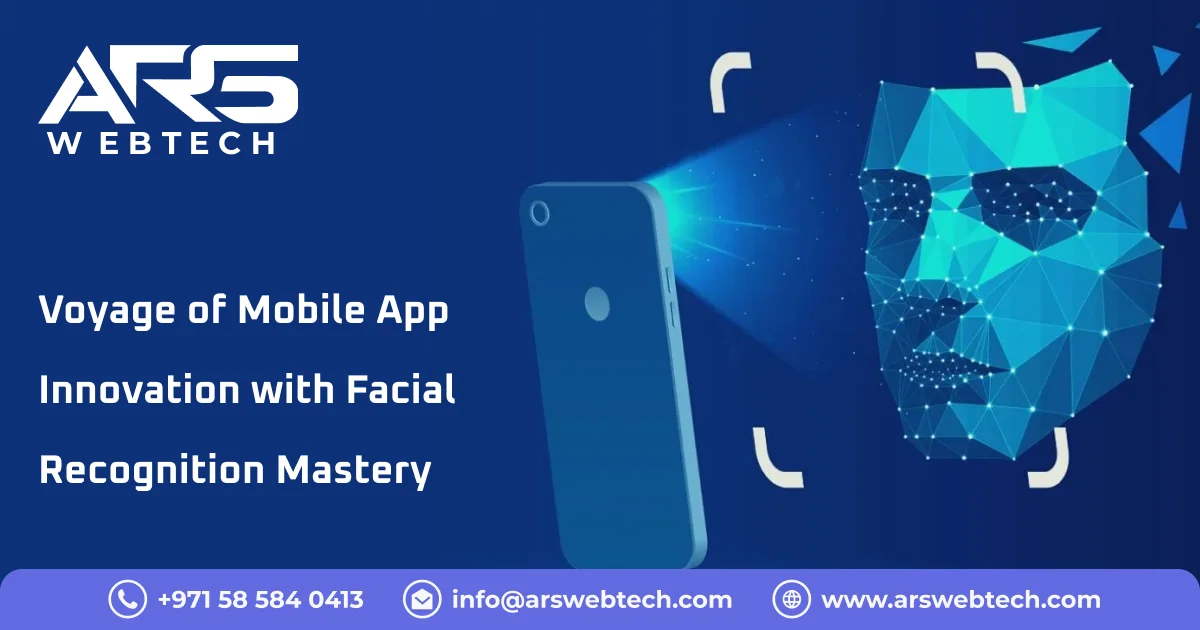Is the concept of facial recognition technology a familiar whisper in your realm? This avant-garde methodology, pivotal in a multitude of smartphones for device activation and engagement, ushers in an epoch of enhanced personal safety, fortress-like security, and enriched user engagement. Let us delve deeper into this journey.
A staggering increase is forecasted, with over 1.4 billion individuals anticipated to employ facial recognition on their handheld devices by 2025, skyrocketing from 671 million in 2020.
Expansion Surge in Facial Recognition Tech
Why does Facial Recognition Technology ascend?
Indeed, navigating the complex and often debated domain of facial recognition is fraught with challenges. Nonetheless, the sector is flourishing, with ARS Webtech pioneers in Dubai leading a transformative shift. Its adoption extends across industries, endowing a plethora of applications with the capability of visual biometric discernment for a diverse array of tasks:
- Biometric authentication for unequivocal identity confirmation
- Automating the checkout flow in commercial ventures
- Augmenting security in workplaces and educational domains
- Client verification
- Identifying patients
- Enlightened banking practices
- Uplifting public safety and enhancing product discovery via visual search
- Crafting marketing endeavors with pinpoint accuracy
- Detecting genetic conditions
- Preventing fraud and enhancing retail security
- Enabling cardless transactions at ATMs
- Recognizing food through images
- Amplifying engagement on social platforms
Harnessing Facial Recognition in Your Application
Before venturing into the creation of facial recognition applications, grasp the essence of the concept. What should your envisioned creation achieve? Here are three strategies to weave FRT into your mobile application post-mastering its fundamentals:
Three Pathways to Facial Recognition Integration in Your App
Leverage Native Face Detection APIs
Whether your aim is iOS or Android app development, or perhaps both, these platforms extend their APIs to assist in embedding facial recognition features into your application.
While these native solutions may limit functionality, they significantly reduce the development overhead for a facial recognition app. Integrating these APIs into your app is crucial for ensuring robust image detection and identification capabilities.
Native APIs shine with their optimization across multiple devices and enhancement through hardware acceleration. For instance, Apple’s Vision API, specializing in computer vision domains, offers detectors for text, barcodes, and faces.
Unleashing the Potential of Recognition: Navigating Mobile App Development with Facial Recognition Technology.
Consider the OpenCV Library
This library is a stalwart in the realm of facial recognition app creation, simplifying the integration of ML and computer vision into applications. OpenCV stands as a beacon for object detection, supporting myriad techniques for identifying various entities, including faces, with commendable efficacy.
Initially crafted to unify the interface of the computer vision field and expedite model innovation, OpenCV’s principal advantage is its cost-free nature. However, weaving it into mobile applications, particularly Android’s facial detection, demands profound expertise.
Opt for a Third-Party Service
A plethora of third-party services exists, offering streamlined and convenient development pathways. Services like Amazon Rekognition, Microsoft Face API, Google's Cloud Vision API, and Kairos can supercharge your applications with FTR capabilities, identifying emotions, ethnicity, and more beyond mere facial recognition. These services, generally subscription-based, promise remarkable functionality.
The Forefront APIs for Facial Recognition in Mobile Applications
APIs stand as pillars supporting business growth. Hence, employing an API for facial recognition app development is ideal, enhancing developer efficiency and enabling the deployment of innovative solutions at reduced costs.
Among the leading facial recognition APIs are:
- Microsoft Face API, renowned for its facial and emotion recognition capabilities, empowering apps to identify and categorize faces and their associated emotions.
- Kairos API, celebrated for its swift and secure face detection, powered by machine learning algorithms.
- Amazon Rekognition, rooted in deep learning technology, allows for expansive analysis without necessitating ML expertise.
- ARS Webtech: Pioneers in Web App Development
At ARS Webtech, we excel in crafting state-of-the-art web applications tailored to your unique requirements. Discover the transformative power of bespoke web applications and enhance your digital footprint with our expertise. Reach out for unparalleled web app development services.
In Conclusion
Facial recognition is steadily cementing its place in mobile device security and user experience enhancement. ARS Webtech, at the forefront of mobile app development, continues to pioneer in real-time facial recognition applications, with our latest innovations marking significant success. Explore the possibilities facial recognition technology offers for your applications by connecting with us.
FAQs:
- Creating a Facial Recognition App: Involves considerations like hardware capabilities, neural network architecture, database selection, API integration, and inference timing.
- Setting Up Face Recognition on Apps: Typically involves navigating to the Android Settings, selecting Security, and configuring face recognition within the Biometrics settings.
- Enhancing Facial Recognition Technology: Improvements can be achieved through deep learning, refining neural networks, and training on diverse, high-quality datasets.
- Preferred Programming Languages for Facial Recognition Systems: Python, C++, Java, and C# are among the top choices for developing facial recognition software.
Last Updated at: 02-04-2024






